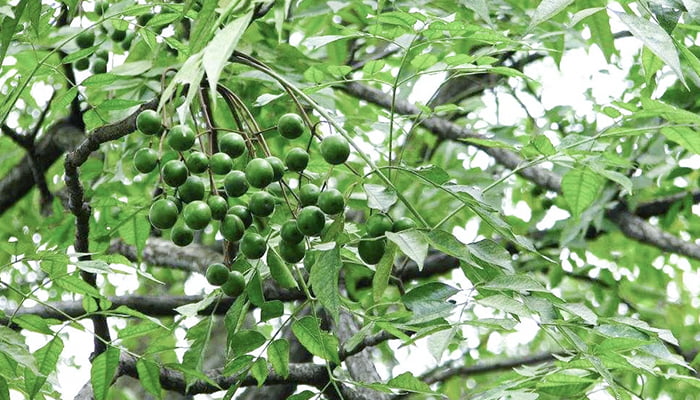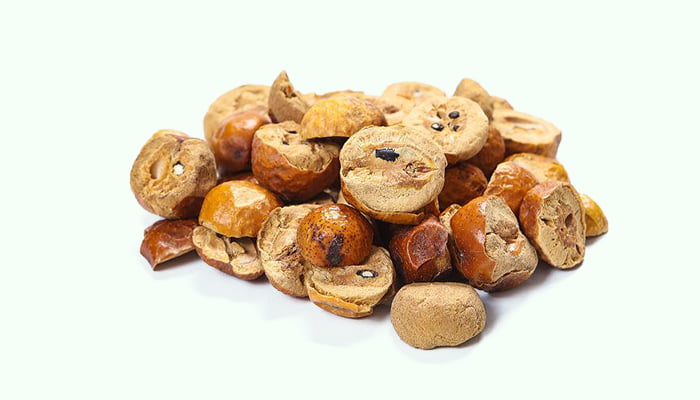What Is Chuan Lian Zi
Chuan Lian Zi commonly known as Fructus Meliae Toosendan is the dried and mature fruit of Melia toosendan Sieb.et Zucc., which is a deciduous tree belonging to the family Meliaceae. It is a relatively practical and common Chinese herbal medicine, which first appeared in <Shennong Ben Cao Jing> in the late Western Han Dynasty (around 100 BCE).
Melia toosendan Sieb.et Zucc. is a varietas of Chinaberry (Melia azedarach). This type of plant prefers a warm and humid environment and is often cultivated in well-drained, rich, sandy loam soil with deep topsoil. They are mainly distributed in the low-altitude wilderness, roadside, or sparse forests of provinces south of the Yellow River in China.
They possess economic and medicinal value. Their wood can be used for construction and furniture, while their fruits, bark, and root skin can be made into traditional Chinese herbal medicines. Traditionally, Chuan Lian Zi produced in Sichuan is considered to be a Daodi medicinal material.

In winter, people gather the ripe fruits of Melia toosendan Sieb.et Zucc., remove impurities, dry them, crush them to use directly, or cut them into thick slices or crush them, stir-fry them, and make them into Chinese herbal medicines.
Chuan Lian Zi contains toosendanal, 2-O-methylvolkensin, meliatoxin B1, trichilin H, toosendanin, meliasenins I-R, methyl kulonate, kulinone, toosendansins E-I, meliatoosenins E-S, rutin, morin, homoeriodictyol, daidzein, kaempferol, clematine, quercetin, isoquercitrin, β-Sitosterol, daucosterine, stigmasterol, volatile oils, organic acids, lignans, glycosides, and some trace elements.
Generally, the plump Chuan Lian Zi with golden-yellow outer skin and yellowish-white flesh are preferred. It looks like a golden bell, which is why it is also referred to as “Golden Bell” or “Jin Ling Zi” in Chinese.
According to the Chinese Pharmacopoeia, the medicinal nature of Chuan Lian Zi is relatively clod, with slight toxicity, and a bitter taste. It has a therapeutic effect on pathological changes in the liver, small intestine, and bladder meridians.
In traditional Chinese medicine, it is often used to soothe the liver and clear heat, promote qi circulation and relieve pain, kill parasites, and treat distending pain in the hypochondrium, abdominal distention and pain, and hernia pain caused by liver depression and qi stagnation, parasitic malnutrition, stomach pain, chronic atrophic gastritis, cholecystitis, acute pancreatitis, chronic prostatitis, chronic hepatitis, acute cholecystitis, biliary infections, biliary ascariasis, roundworm infestations, gallstone disease, testicular swelling and discomfort, testicular hydrocele in children, intestinal behcet’s disease, breast hyperplasia, breast nodules, acute mastitis, irregular menstruation, dysmenorrhea, amenorrhea, abdominal masses, postpartum abdominal pain, menopausal syndrome, stroke-like symptoms, scabies, tinea capitis, and alopecia.
There are approximately 87 kinds of traditional Chinese medicine prescriptions containing it, Jin Ling Zi San, Ju He Wan, and Yi Guan Jian.
Benefits
- Anti-inflammation, inhibiting the rise in vascular permeability induced by acetic acid and paw edema induced by carrageenin in mice [1].
- Increasing the pain threshold and inhibiting the pain caused by the hot plate experiment and acetic acid experiment in mice.
- Anti-oxidation, scavenging superoxide radicals, hydroxyl radicals, DPPH radicals, and nitrite radicals [2].
- Soothing the liver and clearing heat, treating distending pain in the hypochondrium, abdominal distention and pain, and hernia pain caused by liver depression and qi stagnation or liver depression transforming into the fire.
- Killing parasites, treating abdominal pain, and vomiting of watery fluid caused by parasitic malnutrition.
- Treating scabies, tinea capitis, and alopecia.
- Toosendanin is capable of inhibiting the lipogenesis of adipocytes by activating the Wnt/β-catenin pathway. It possesses anti-obesity effects [3].
- Its extract attenuates endothelin-1-stimulated pigmentation in human epidermal equivalents through the interruption of PKC activity within melanocytes [4].
- Its ethanol extract may treat Alzheimer’s disease by lowering aβ amyloid accumulation [5].
- Its extract increases the production of ceramides in keratinocytes and may be used to develop products for improving the skin barrier function [6].
- Research indicates that its ethanol extract reduces influenza A virus infection by influencing viral entrance, the polymerase acidic protein of the RNA polymerase complex, and Mx1 induction [7].
- Both in vitro and in vivo experiments have demonstrated that its extract can inhibit oocyst sporulation and prevent infection by Eimeria tenella in broiler chickens [8].
- In various studies targeting multiple types of cancer, toosendanin has been demonstrated to have anticancer activity, including against human hepatocellular carcinoma cell lines [SMMC-7721 (p53+) and Hep3B (p53-)], Ewing’s sarcoma (ES), human SK-ES-1 cells, human gastric cancer cells (BGC-823), U20S, MCF-7, HL-60, and A549 tumor cell lines, as well as lung cancer and breast cancer [9].
Combinations
- It can be combined with Yan Hu Suo (Rhizoma Corydalis) to treat distending pain in the hypochondrium, and abdominal distention and pain caused by liver depression and qi stagnation or liver depression transforming into the fire.
- It can be used in combination with Chai Hu (Radix Bupleuri), Bai Shao (White Peony Root), Zhi Qiao (Fructus Aurantii), etc. to treat pain in the chest and abdomen caused by liver-stomach disharmony.
- It can be used in combination with Yan Hu Suo (Rhizoma Corydalis), Xiang Fu (Rhizoma Cyperi), Ju He (Semen Citri Reticulatae), etc. to treat hernia pain caused by heat.
- It can be used in combination with Xiao Hui Xiang (Fructus Foeniculi), Mu Xiang (Radix Aucklandiae), Wu Zhu Yu (Evodiae Fructus), etc. to treat periumbilical colic due to cold.
- It can be used in combination with Shi Jun Zi (Fructus Quisqualis), Bing Lang (Semen Arecae), etc. to treat abdominal pain caused by parasitic malnutrition.
- It can be used in combination with Da Huang (Radix et Rhizoma Rhei), Yu Jin (Turmeric Tuber), Shan Zha (Hawthorn Fruit), and Ji Xue Cao (Centella Asiatica) to treat acute cholecystitis.
- It can be used in combination with Ru Xiang (Frankincense), Mo Yao (Myrrh), Long Dan Cao (Radix Gentianae), Da Huang (Radix et Rhizoma Rhei), etc. to treat biliary infections.
Side Effects
- Chuan Lian Zi is toxic, with its main toxic components being toosendanin and meliasenins.
- It has a stimulatory effect on the gastrointestinal tract, can be harmful to the liver, disrupts the normal transmission function of neuromuscular junctions, and can lead to acute circulatory failure and central respiratory failure, resulting in death.
- Overdose of it may cause dizziness, headaches, lethargy, nausea, vomiting, or abdominal pain.
- In severe cases, it may cause respiratory paralysis, toxic hepatitis, visceral bleeding, or mental disorders.
Precautions and Warnings
- The dosage of Chuan Lian Zi should be controlled between 5-10g.
- It can be made into decoctions, pills, or powdered forms for external application.
- People who are allergic to Chuan Lian Zi should not take it.
- Patients with deficiency cold in the spleen and stomach should not take it.
- Pregnant women should not take it.
- Lactating women, children, and the elderly and infirm should be taken under the guidance of a physician.
- Stir-frying Chuan Lian Zi can moderate its bitter and cold medicinal nature, reducing its toxic side effects.
